Abstract
1. We carried out experiments to assess the cardiac and regional haemodynamic effects of single or repeated injections of the novel bradycardic agent. S16257, (7,8-dimethoxy 3-[3-([(IS)-(4,5-dimethoxybenzocyclobutan-1- yl)methyl]methylamino)propyl] 1,3,4,5-tetrahydro-2H-benzapin 2-one), in conscious rats. 2. In the first experiment, male Long Evans rats were chronically instrumented for the measurement of cardiac or regional haemodynamics (n = 9 in each group), and, on separate experimental days, were randomized to receive i.v. bolus injections of vehicle (5% dextrose) or S16257 at a dose of 1 mg kg-1. 3. In animals instrumented for the measurement of cardiac haemodynamics (n = 9), following injection of vehicle, there were no immediate changes, and 7-8 h later there were slight reductions in heart rate and mean arterial blood pressure only. Injection of S16257 caused an immediate, transient, pressor effect but thereafter there were reductions in heart rate, mean arterial blood pressure, cardiac index and total peripheral conductance, together with increases in stroke index and peak aortic flow. The integrated decreases in heart rate, mean arterial blood pressure, cardiac index and total peripheral conductance and increases in stroke index, peak aortic flow, dF/dtmax and central venous pressure following S16257 were all significantly greater than the changes after vehicle injection. After injection of S16257, the fall in heart rate and fall in cardiac index were not linearly related. 4. In animals instrumented for the measurement of regional haemodynamics (n = 9).(ABSTRACT TRUNCATED AT 250 WORDS)
Full text
PDF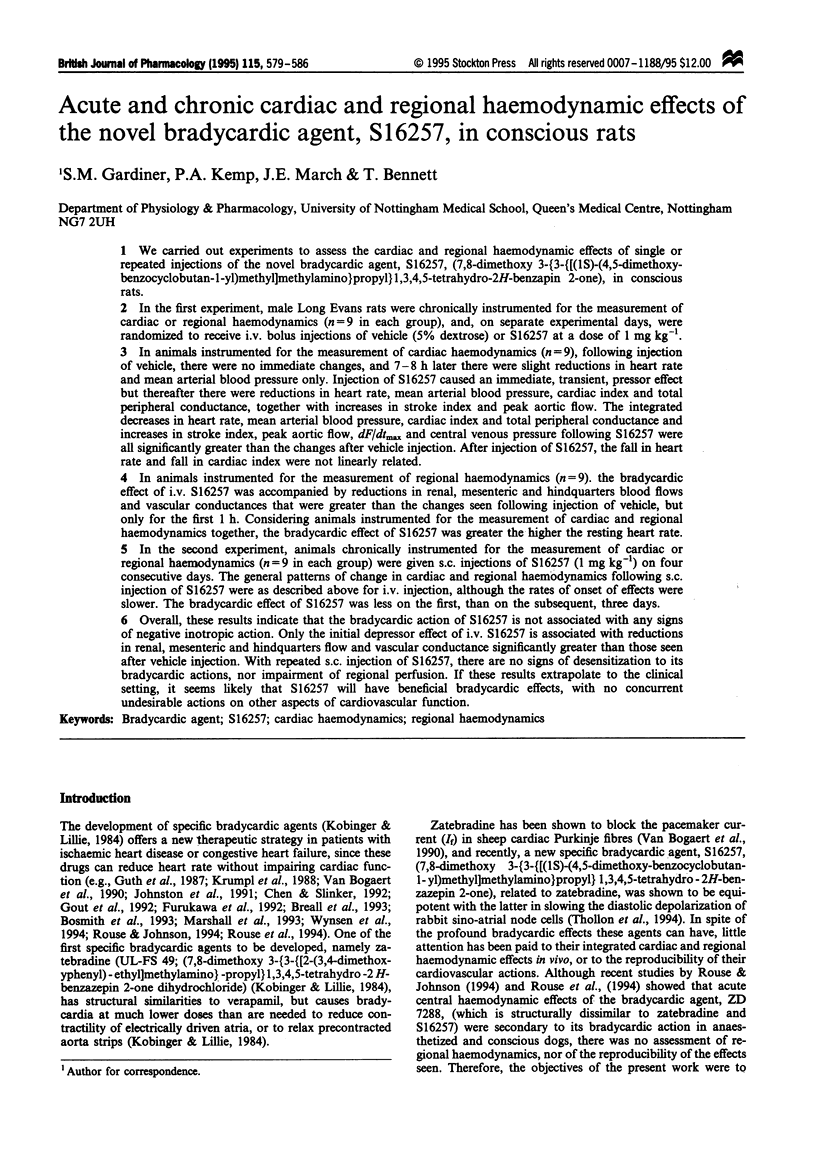

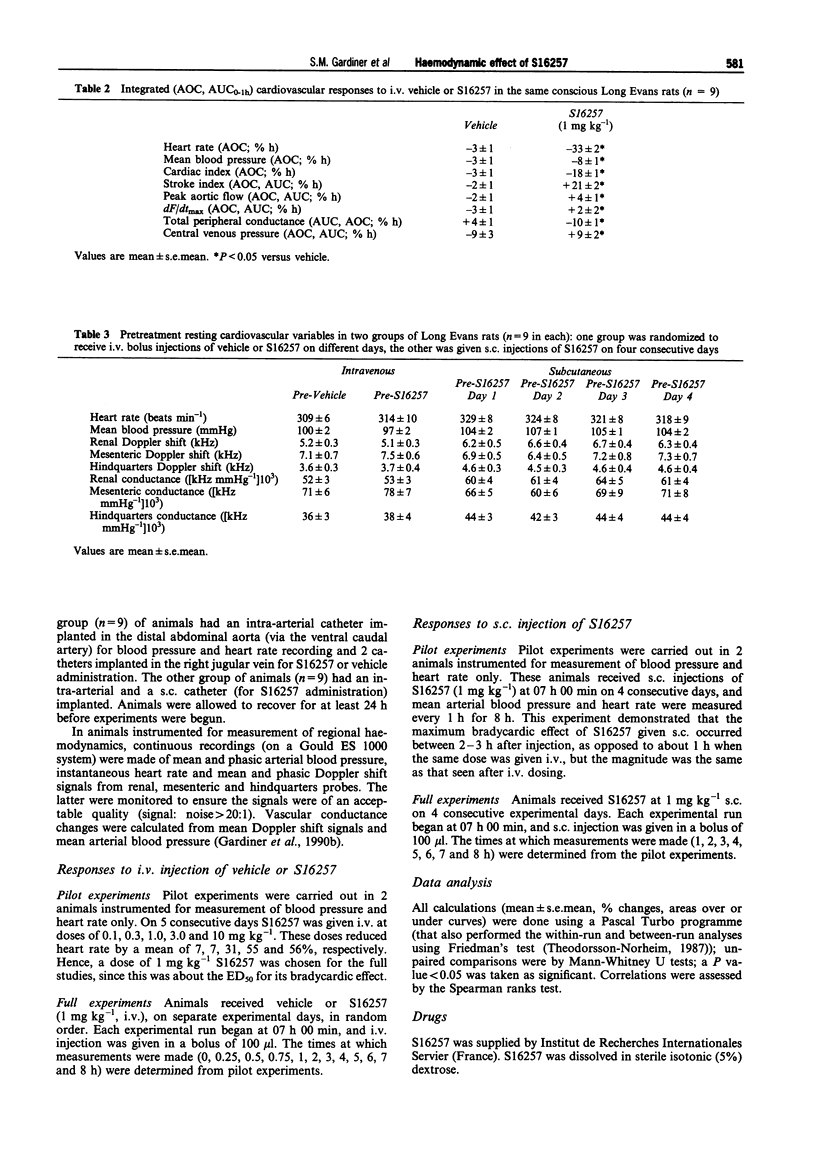
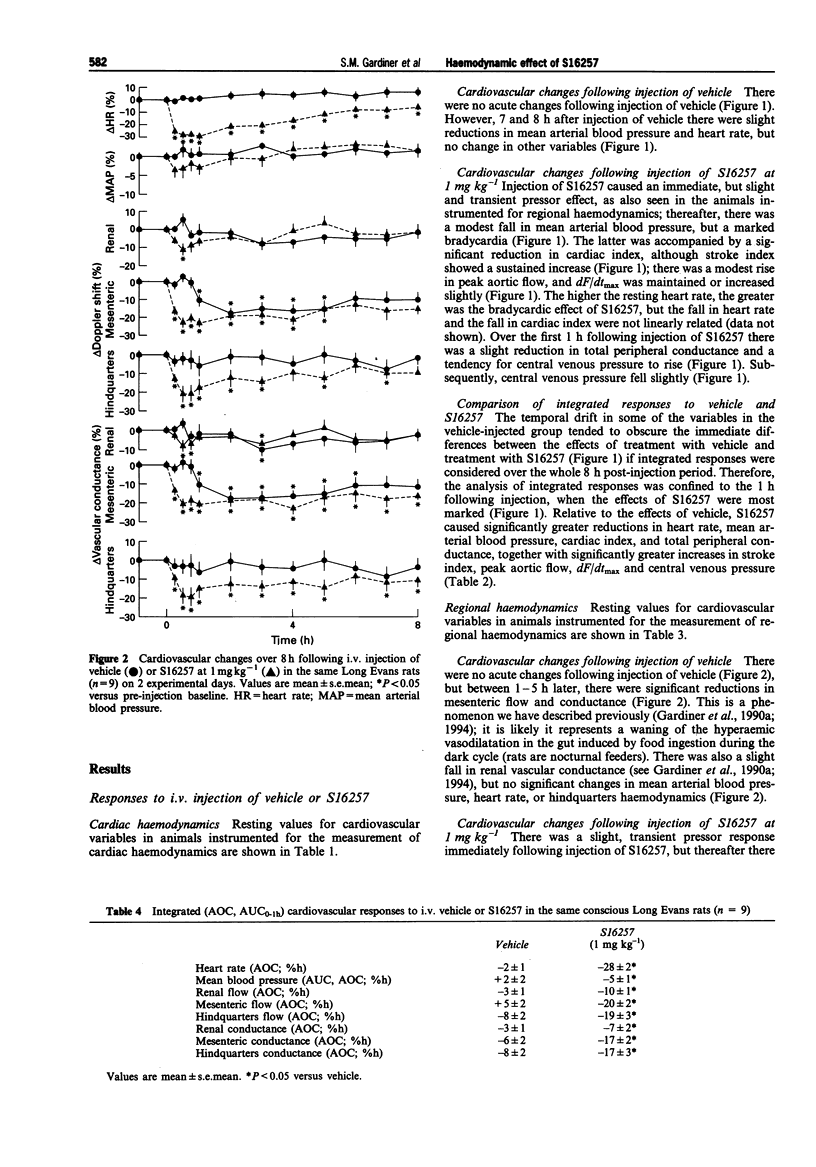
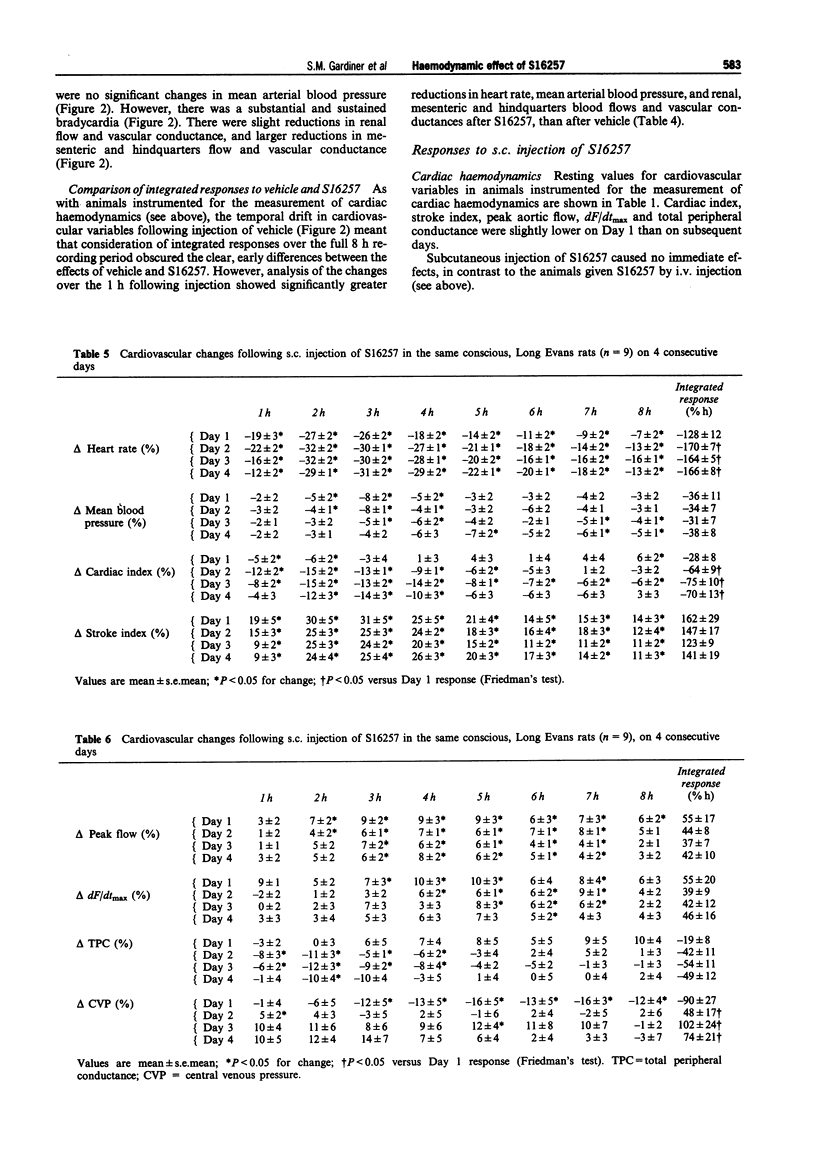
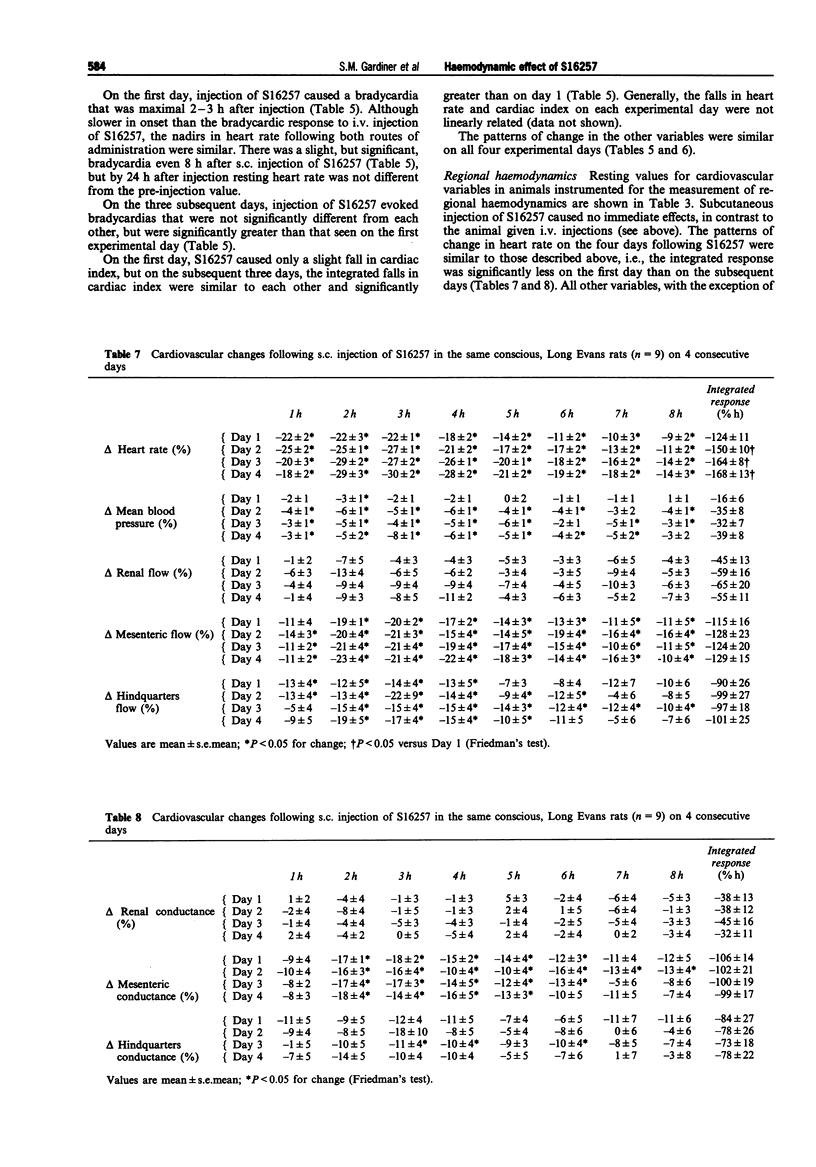
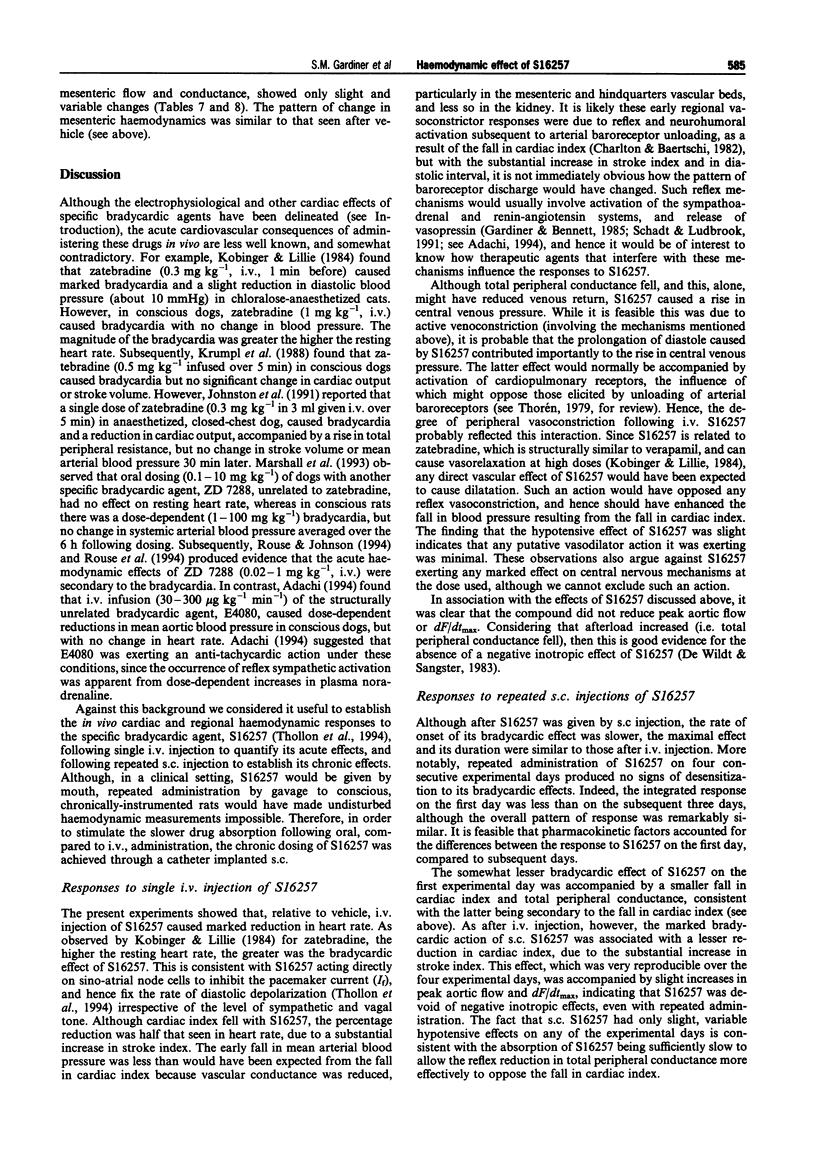
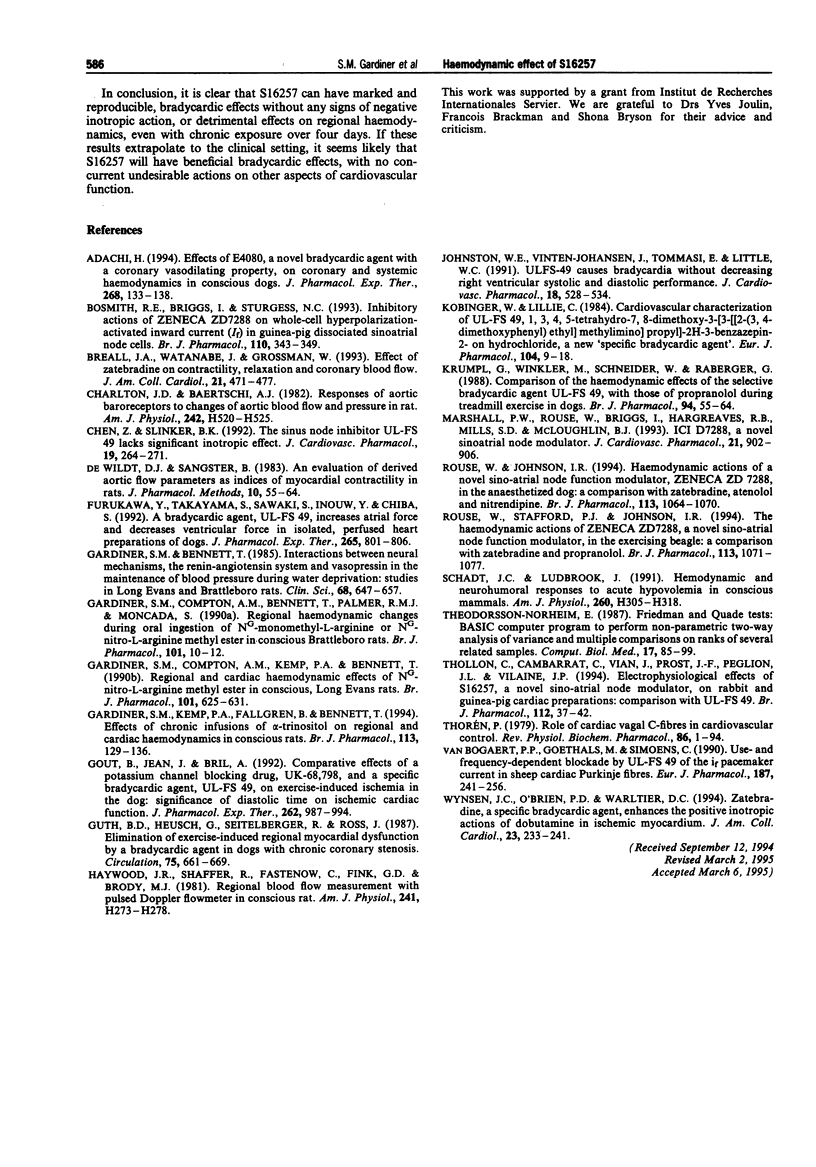
Selected References
These references are in PubMed. This may not be the complete list of references from this article.
- Adachi H. Effects of E4080, a novel bradycardic agent with a coronary vasodilating property, on coronary and systemic hemodynamics in conscious dogs. J Pharmacol Exp Ther. 1994 Jan;268(1):133–138. [PubMed] [Google Scholar]
- BoSmith R. E., Briggs I., Sturgess N. C. Inhibitory actions of ZENECA ZD7288 on whole-cell hyperpolarization activated inward current (If) in guinea-pig dissociated sinoatrial node cells. Br J Pharmacol. 1993 Sep;110(1):343–349. doi: 10.1111/j.1476-5381.1993.tb13815.x. [DOI] [PMC free article] [PubMed] [Google Scholar]
- Breall J. A., Watanabe J., Grossman W. Effect of zatebradine on contractility, relaxation and coronary blood flow. J Am Coll Cardiol. 1993 Feb;21(2):471–477. doi: 10.1016/0735-1097(93)90691-s. [DOI] [PubMed] [Google Scholar]
- Charlton J. D., Baertschi A. J. Responses of aortic baroreceptors to changes of aortic blood flow and pressure in rat. Am J Physiol. 1982 Apr;242(4):H520–H525. doi: 10.1152/ajpheart.1982.242.4.H520. [DOI] [PubMed] [Google Scholar]
- Chen Z. Y., Slinker B. K. The sinus node inhibitor UL-FS 49 lacks significant inotropic effect. J Cardiovasc Pharmacol. 1992 Feb;19(2):264–271. doi: 10.1097/00005344-199202000-00015. [DOI] [PubMed] [Google Scholar]
- Furukawa Y., Takayama S., Sawaki S., Inoue Y., Chiba S. A bradycardic agent, UL-FS 49, increases atrial force and decreases ventricular force in isolated, perfused heart preparations of dogs. J Pharmacol Exp Ther. 1993 May;265(2):801–806. [PubMed] [Google Scholar]
- Gardiner S. M., Bennett T. Interactions between neural mechanisms, the renin-angiotensin system and vasopressin in the maintenance of blood pressure during water deprivation: studies in Long Evans and Brattleboro rats. Clin Sci (Lond) 1985 Jun;68(6):647–657. doi: 10.1042/cs0680647. [DOI] [PubMed] [Google Scholar]
- Gardiner S. M., Compton A. M., Bennett T., Palmer R. M., Moncada S. Regional haemodynamic changes during oral ingestion of NG-monomethyl-L-arginine or NG-nitro-L-arginine methyl ester in conscious Brattleboro rats. Br J Pharmacol. 1990 Sep;101(1):10–12. doi: 10.1111/j.1476-5381.1990.tb12079.x. [DOI] [PMC free article] [PubMed] [Google Scholar]
- Gardiner S. M., Compton A. M., Kemp P. A., Bennett T. Regional and cardiac haemodynamic effects of NG-nitro-L-arginine methyl ester in conscious, Long Evans rats. Br J Pharmacol. 1990 Nov;101(3):625–631. doi: 10.1111/j.1476-5381.1990.tb14131.x. [DOI] [PMC free article] [PubMed] [Google Scholar]
- Gardiner S. M., Kemp P. A., Fallgren B., Bennett T. Effects of chronic infusions of alpha-trinositol on regional and cardiac haemodynamics in conscious rats. Br J Pharmacol. 1994 Sep;113(1):129–136. doi: 10.1111/j.1476-5381.1994.tb16184.x. [DOI] [PMC free article] [PubMed] [Google Scholar]
- Gout B., Jean J., Bril A. Comparative effects of a potassium channel blocking drug, UK-68,798, and a specific bradycardic agent, UL-FS 49, on exercise-induced ischemia in the dog: significance of diastolic time on ischemic cardiac function. J Pharmacol Exp Ther. 1992 Sep;262(3):987–994. [PubMed] [Google Scholar]
- Guth B. D., Heusch G., Seitelberger R., Ross J., Jr Elimination of exercise-induced regional myocardial dysfunction by a bradycardiac agent in dogs with chronic coronary stenosis. Circulation. 1987 Mar;75(3):661–669. doi: 10.1161/01.cir.75.3.661. [DOI] [PubMed] [Google Scholar]
- Haywood J. R., Shaffer R. A., Fastenow C., Fink G. D., Brody M. J. Regional blood flow measurement with pulsed Doppler flowmeter in conscious rat. Am J Physiol. 1981 Aug;241(2):H273–H278. doi: 10.1152/ajpheart.1981.241.2.H273. [DOI] [PubMed] [Google Scholar]
- Johnston W. E., Vinten-Johansen J., Tommasi E., Little W. C. ULFS-49 causes bradycardia without decreasing right ventricular systolic and diastolic performance. J Cardiovasc Pharmacol. 1991 Oct;18(4):528–534. doi: 10.1097/00005344-199110000-00008. [DOI] [PubMed] [Google Scholar]
- Kobinger W., Lillie C. Cardiovascular characterization of UL-FS 49, 1,3,4,5-tetrahydro-7,8-dimethoxy-3-[3-][2-(3,4-dimethoxyphenyl)ethyl] methylimino]propyl]-2H-3-benzazepin-2-on hydrochloride, a new "specific bradycardic agent". Eur J Pharmacol. 1984 Sep 3;104(1-2):9–18. doi: 10.1016/0014-2999(84)90363-7. [DOI] [PubMed] [Google Scholar]
- Krumpl G., Winkler M., Schneider W., Raberger G. Comparison of the haemodynamic effects of the selective bradycardic agent UL-FS 49, with those of propranolol during treadmill exercise in dogs. Br J Pharmacol. 1988 May;94(1):55–64. doi: 10.1111/j.1476-5381.1988.tb11499.x. [DOI] [PMC free article] [PubMed] [Google Scholar]
- Marshall P. W., Rouse W., Briggs I., Hargreaves R. B., Mills S. D., McLoughlin B. J. ICI D7288, a novel sinoatrial node modulator. J Cardiovasc Pharmacol. 1993 Jun;21(6):902–906. doi: 10.1097/00005344-199306000-00008. [DOI] [PubMed] [Google Scholar]
- Rouse W., Johnson I. R. Haemodynamic actions of a novel sino-atrial node function modulator, ZENECA ZD7288, in the anaesthetized dog: a comparison with zatebradine, atenolol and nitrendipine. Br J Pharmacol. 1994 Nov;113(3):1064–1070. doi: 10.1111/j.1476-5381.1994.tb17101.x. [DOI] [PMC free article] [PubMed] [Google Scholar]
- Rouse W., Stafford P. J., Johnson I. R. The haemodynamic actions of ZENECA ZD7288, a novel sino-atrial node function modulator, in the exercising beagle: a comparison with zatebradine and propranolol. Br J Pharmacol. 1994 Nov;113(3):1071–1077. doi: 10.1111/j.1476-5381.1994.tb17102.x. [DOI] [PMC free article] [PubMed] [Google Scholar]
- Schadt J. C., Ludbrook J. Hemodynamic and neurohumoral responses to acute hypovolemia in conscious mammals. Am J Physiol. 1991 Feb;260(2 Pt 2):H305–H318. doi: 10.1152/ajpheart.1991.260.2.H305. [DOI] [PubMed] [Google Scholar]
- Theodorsson-Norheim E. Friedman and Quade tests: BASIC computer program to perform nonparametric two-way analysis of variance and multiple comparisons on ranks of several related samples. Comput Biol Med. 1987;17(2):85–99. doi: 10.1016/0010-4825(87)90003-5. [DOI] [PubMed] [Google Scholar]
- Thollon C., Cambarrat C., Vian J., Prost J. F., Peglion J. L., Vilaine J. P. Electrophysiological effects of S 16257, a novel sino-atrial node modulator, on rabbit and guinea-pig cardiac preparations: comparison with UL-FS 49. Br J Pharmacol. 1994 May;112(1):37–42. doi: 10.1111/j.1476-5381.1994.tb13025.x. [DOI] [PMC free article] [PubMed] [Google Scholar]
- Thorén P. Role of cardiac vagal C-fibers in cardiovascular control. Rev Physiol Biochem Pharmacol. 1979;86:1–94. doi: 10.1007/BFb0031531. [DOI] [PubMed] [Google Scholar]
- Van Bogaert P. P., Goethals M., Simoens C. Use- and frequency-dependent blockade by UL-FS 49 of the if pacemaker current in sheep cardiac Purkinje fibres. Eur J Pharmacol. 1990 Oct 9;187(2):241–256. doi: 10.1016/0014-2999(90)90011-t. [DOI] [PubMed] [Google Scholar]
- Wynsen J. C., O'Brien P. D., Warltier D. C. Zatebradine, a specific bradycardic agent, enhances the positive inotropic actions of dobutamine in ischemic myocardium. J Am Coll Cardiol. 1994 Jan;23(1):233–241. doi: 10.1016/0735-1097(94)90526-6. [DOI] [PubMed] [Google Scholar]
- de Wildt D. J., Sangster B. An evaluation of derived aortic flow parameters as indices of myocardial contractility in rats. J Pharmacol Methods. 1983 Aug;10(1):55–64. doi: 10.1016/0160-5402(83)90014-1. [DOI] [PubMed] [Google Scholar]


